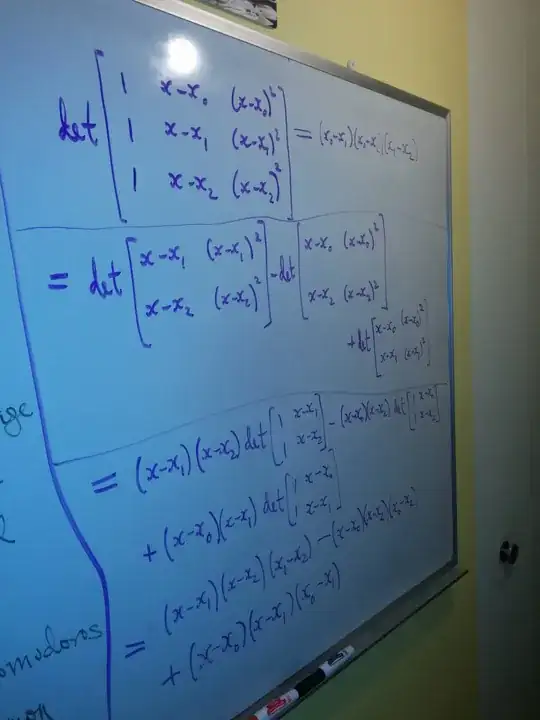Let $k$ be a field and $K=k(x_0,x_1,\ldots, x_n)[x]$. Define $$\mathcal{L}_k(x)\triangleq \prod_{\substack{j=0\\ j\ne k}}^n\frac{x-x_j}{x_k-x_j}.$$
Is there a purely combinatorial way to show that $$\sum_{k=0}^n\mathcal{L}_k(x)=1?$$
That is, I would like to consider the $\mathcal{L}_k(x)$ as formal polynomials, not as functions. I am aware of proof by interpolation, but I think there must be an interesting combinatorial proof using counting arguments with the indices.
My attempt.
To directly add the summands together, we need a common denominator. Let $R_n=\{0,\ldots, n\}$, $S=\{(i,j)\in R_n\times R_n |j<i\}$, and $S_k=\{(i,j)\in S | i=k\text{ or }j=k\}$.
First, note that
$$\begin{eqnarray*}\prod_{\substack{j=0\\ j\ne k}}^n\frac{1}{x_k-x_j}&=&
\prod_{\substack{j=0\\ j< k}}^n\frac{1}{x_k-x_j}\prod_{\substack{j=0\\ j> k}}^n\frac{1}{-(x_j-x_k)}\\&=&\prod_{j=0}^{k-1}\frac{1}{x_k-x_j}\prod_{j=k+1}^n\frac{1}{-(x_j-x_k)}\\
&=&(-1)^{n-k}\prod_{(i,j)\in S_k}\frac{1}{x_i-x_j}
\end{eqnarray*}$$
To get a common denominator, we therfore multiply each term by $$\frac{\prod_{(i,j)\in S\setminus S_k}x_i-x_j}{\prod_{(i,j)\in S\setminus S_k}x_i-x_j}$$
to obtain $$\prod_{j<i}\frac{1}{x_i-x_j}\sum_{k=0}^n\left((-1)^{n-k}\prod_{\substack{j=0\\ j\ne k}}^n(x-x_j)\prod_{(i,j)\in S\setminus S_k}(x_i-x_j)\right)$$
...and here is where I can't get stuck, can't think of a how to continue.
